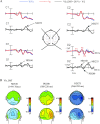Early cross-modal interactions in auditory and visual cortex underlie a sound-induced visual illusion
- PMID: 17428990
- PMCID: PMC2905511
- DOI: 10.1523/JNEUROSCI.4912-06.2007
Early cross-modal interactions in auditory and visual cortex underlie a sound-induced visual illusion
Abstract
When a single flash of light is presented interposed between two brief auditory stimuli separated by 60-100 ms, subjects typically report perceiving two flashes (Shams et al., 2000, 2002). We investigated the timing and localization of the cortical processes that underlie this illusory flash effect in 34 subjects by means of 64-channel recordings of event-related potentials (ERPs). A difference ERP calculated to isolate neural activity associated with the illusory second flash revealed an early modulation of visual cortex activity at 30-60 ms after the second sound, which was larger in amplitude in subjects who saw the illusory flash more frequently. These subjects also showed this early modulation in response to other combinations of auditory and visual stimuli, thus pointing to consistent individual differences in the neural connectivity that underlies cross-modal integration. The overall pattern of cortical activity associated with the cross-modally induced illusory flash, however, differed markedly from that evoked by a real second flash. A trial-by-trial analysis showed that short-latency ERP activity localized to auditory cortex and polymodal cortex of the temporal lobe, concurrent with gamma bursts in visual cortex, were associated with perception of the double-flash illusion. These results provide evidence that perception of the illusory second flash is based on a very rapid dynamic interplay between auditory and visual cortical areas that is triggered by the second sound.
Figures











References
-
- Andersen TS, Tiippana K, Sams M. Factors influencing audiovisual fission and fusion illusions. Brain Res Cogn Brain Res. 2004;21:301–308. - PubMed
-
- Arden GB, Wolf JE, Messiter C. Electrical activity in visual cortex associated with combined auditory and visual stimulation in temporal sequences known to be associated with a visual illusion. Vision Res. 2003;43:2469–2478. - PubMed
-
- Bavelier D, Neville HJ. Cross-modal plasticity: where and how? Nat Rev Neurosci. 2002;3:443–452. - PubMed
-
- Bhattacharya J, Shams L, Shimojo S. Sound-induced illusory flash perception: role of gamma band responses. NeuroReport. 2002;13:1727–1730. - PubMed
Publication types
MeSH terms
Grants and funding
LinkOut - more resources
Full Text Sources
